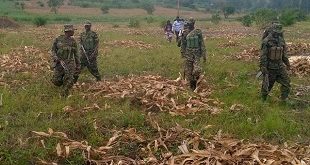
Kampala, Uganda | THE INDEPENDENT | Oliver Lalani is the Executive Director at Roofing Rolling Mills (RRM). He spoke to Isaac Khisa about Uganda’s steel industry and its future outlook.
What is your assessment of the performance of Uganda’s steel industry in the country at the moment?
The Steel industry in Uganda has evolved greatly in scale and scope over the years. Consumption of steel per capita currently stands at around 15 Kg/Capita per annum in Uganda whereas it is around 45 kg in Kenya. The world average consumption is close to 250 Kg which shows that our industry is still at its infancy stage in comparison with developed countries.
But as the economy continues to develop and industrialization grows, steel will continue to be a critical component which will grow in demand. The development of various mega- infrastructural projects, the emergence of the oil and gas sector, Uganda’s high population growth rate, access to regional markets and the rapidly growing urbanization are all opportunities for growth of this sector.
As Roofings group, our output grew by more than 12% in 2017 to nearly 200,000 tonnes of steel sales in 2017. With the huge investment we have completed in Namanve, we still have ample capacity on ground to satisfy the growth in demand.
Uganda’s steel industry has also vertically integrated over the last 5 years or so. Previously, Roofings Group used to import Galvanised and Colour Coated steel, which we are now making on ground. This presents a great opportunity for our economy since we are capturing much more value.
The value addition in the sector can further grow with the abundance of high quality Iron Ore in South Western Uganda. With the large natural gas reserves in the region we can expect huge transformation in the years to come where Uganda will be making steel products from its own iron and exporting to the region.
However, the future of the sector will depend on; the costs of doing manufacturing in the region vis a vis COMESA, SADC and other steel processing countries, the assurance of markets i.e. the effectiveness of BUBU for future infrastructural expenditure and the removal of Non-Tariff Barriers to enhance intra-regional and cross regional trade.
It must also be said that the industry is getting unprecedented support from the government in ensuring that it delivers the true economic opportunity which it has done to many industrialized nations in the past. Including exports, Uganda’s total steel market is around 585,000 tonnes per annum of which Roofings controls over 30%. We are very optimistic of the future and look forward to being a key partner in developing the industry further.
As at the end of 2016, steel sector had a big fight with government over local content in the ongoing infrastructural development projects. How has that issue been resolved?
We are now getting contracts from the ongoing infrastructural development projects especially dams, roads and bridge construction. Though we entered this area late since the dams are near completion, the future looks very positive especially with the huge funds allocated to oil and gas, transport and energy infrastructure.
How is the performance of the regional markets in general and South Sudan in particular as far as export of Ugandan steel is concerned?
Our exports are mainly destined to the Democratic Republic of Congo, Burundi, Rwanda, South Sudan, and Northern Tanzania. With regard to trade with South Sudan, business has slightly improved but not near to the level it was in 2011 before internal conflict broke out in 2013. Out of the roughly 4000 tons exported monthly, 15% is destined to South Sudan. We do hope that once South Sudan stabilizes, it will stimulate growth of Ugandan companies. The regional market continues to be a focal point for our business since the population is far greater than that of Uganda alone. Construction in the region is booming and there is a need for high quality steel.
What strategies are you taking to drive growth of Roofings Group?
The sets of values which our company was founded on are quality, diversity, customer focus, integrity and innovation. Everything we do revolves around these aspects and value for money. In our recent investment in RRM, we have taken on a partner from Japan to ensure that we produce only to the highest world standard. We are continuously enhancing and diversifying our product range to ensure that we have a full solution under one roof. For example, we are currently in the process of adding two new forming lines to give more choice to the market amongst other initiatives. It’s imperative for us to have the right amount of inventories to serve the ever growing needs of the market, this is especially the case in Uganda since we are a landlocked country. Our continuous emphasis on ethical business practices has enabled us to be trusted partners of Government in enhancing the steel sector especially with regards to playing field.
Adding on to that, the professional workforce which we have built over the years is a large part of our success factor, but the investment in world class equipment and most stringent quality checks remains paramount to the strength of Roofings in the market.
Finally, we are continuously working with our dealers to see that our products are well stocked and easily accessible to all corners of the country and the region. We care a lot about the customer experience and are strategizing that we continuously enhance this experience.
You also had a plan to use local iron ore towards steel production. Any update?
At the moment, we do not have capacity to melt Ugandan Iron Ore. With time, we are planning to expand and have a Direct-reduced iron (DRI) plant which we can use to melt ore.
The biggest setback in this whole plan is that Uganda doesn’t have a reducing agent. Iron Ore has a lot of impurities, with only approximately 68% being steel (in Uganda) so you need a huge amount of coal or natural gas to reduce impurities. At the moment, importing coking coal from South Africa is very expensive. Natural gas is plentiful in Tanzania but we need a pipeline to transport the gas to the iron ore areas to process the iron ore. We are working with the government most specifically, National Planning Authority, to have a more integrated steel industry in Uganda. It is therefore likely to take some time.
Above all this, consumers are always looking forward for reduction in steel prices. Any hope of fall in prices soon?
Our prices are determined by the international steel prices. This year we have been quite fortunate that the shilling remained stable which is one of the factors in our price decisions. We still import most of our raw materials, all valued in dollars. However, international steel prices have picked up last year mainly due to the reduction in production capacity in China as they strive to control pollution. However, prices in Uganda will become more competitive in the future when we ramp up production, start benefiting from reduced costs of doing business and further enjoying economies of scale.
Some challenges if, any, as you go a long with your business?
One of our challenges is in the quality of electricity available at this moment. At RRM in Namamve we run furnaces, rolling mills and cold rolling mills with huge motors. Our electricity demand is about 15-20MW. The main challenge is not the quantity of electricity available but it’s in the fluctuations in the load of electricity supplied which can lead to stoppages and sets us back in terms of competitiveness in production as a result of increased costs. UMEME (Electricity distributor) is trying to eliminate this issue with the setting up of a sub-station in our plant which will help us tremendously. Another challenge is the availability of skills given the modern technology which we employ. We are going to great lengths to train our employees in house and also sending engineers to countries like Japan and Germany to enhance their skills. The issue of product standards continues to be a threat to consumers and the local industry as a whole. There is a large influx of substandard products from outside, as well as factories in Uganda producing below standard. This makes our genuine products look expensive at times but in most cases when we measure the specs of the ‘cheaper’ product, we come to find that where the price saving is 10%, the weight of the item is less by 15%, making the end user 5% worse of in choosing some of these products on the shelf. We pledge to continue to work with UNBS and the regional standards bodies to ensure that the population seizes to be cheated.
 The Independent Uganda: You get the Truth we Pay the Price
The Independent Uganda: You get the Truth we Pay the Price


